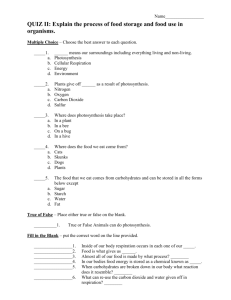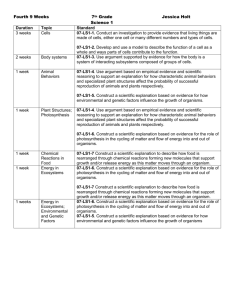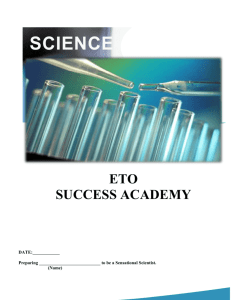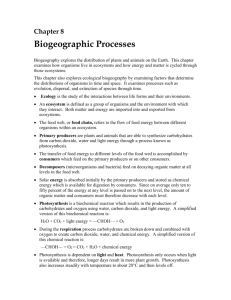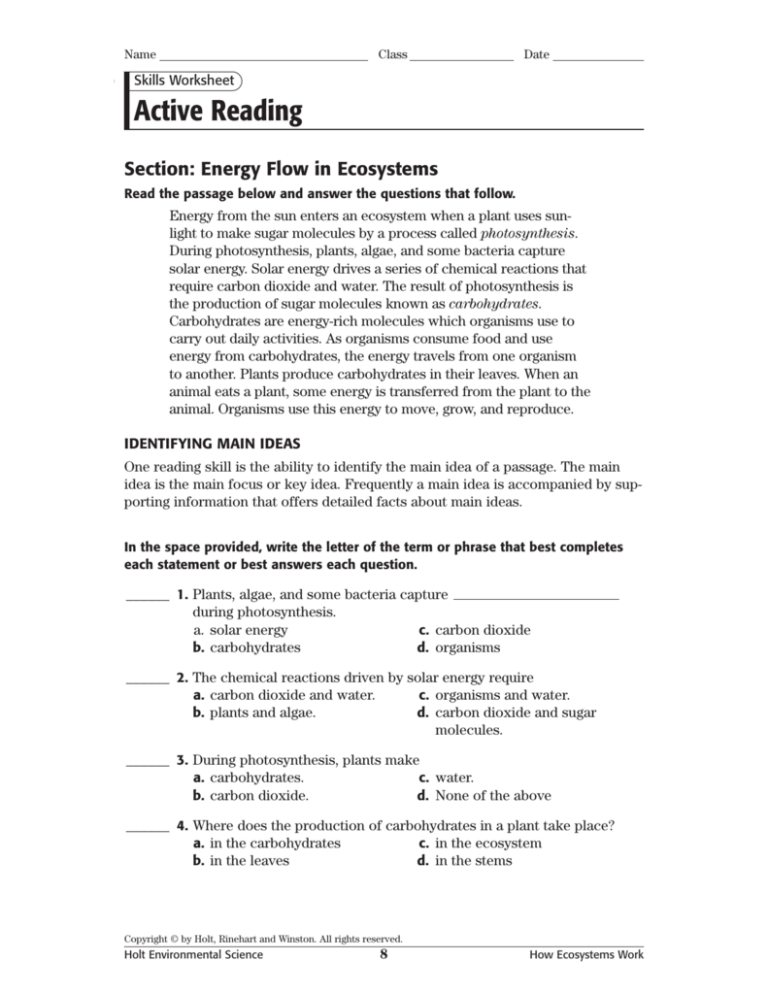
Name
Class
Date
Skills Worksheet
Active Reading
Section: Energy Flow in Ecosystems
Read the passage below and answer the questions that follow.
Energy from the sun enters an ecosystem when a plant uses sunlight to make sugar molecules by a process called photosynthesis.
During photosynthesis, plants, algae, and some bacteria capture
solar energy. Solar energy drives a series of chemical reactions that
require carbon dioxide and water. The result of photosynthesis is
the production of sugar molecules known as carbohydrates.
Carbohydrates are energy-rich molecules which organisms use to
carry out daily activities. As organisms consume food and use
energy from carbohydrates, the energy travels from one organism
to another. Plants produce carbohydrates in their leaves. When an
animal eats a plant, some energy is transferred from the plant to the
animal. Organisms use this energy to move, grow, and reproduce.
IDENTIFYING MAIN IDEAS
One reading skill is the ability to identify the main idea of a passage. The main
idea is the main focus or key idea. Frequently a main idea is accompanied by supporting information that offers detailed facts about main ideas.
In the space provided, write the letter of the term or phrase that best completes
each statement or best answers each question.
______ 1. Plants, algae, and some bacteria capture
during photosynthesis.
c. carbon dioxide
a. solar energy
b. carbohydrates
d. organisms
______ 2. The chemical reactions driven by solar energy require
a. carbon dioxide and water.
c. organisms and water.
b. plants and algae.
d. carbon dioxide and sugar
molecules.
______ 3. During photosynthesis, plants make
a. carbohydrates.
c. water.
b. carbon dioxide.
d. None of the above
______ 4. Where does the production of carbohydrates in a plant take place?
a. in the carbohydrates
c. in the ecosystem
b. in the leaves
d. in the stems
Copyright © by Holt, Rinehart and Winston. All rights reserved.
Holt Environmental Science
8
How Ecosystems Work
Name
Class
Date
Active Reading continued
VOCABULARY DEVELOPMENT
Read each question and write the answer in the space provided.
5. Energy-rich molecules that organisms use to carry out daily activities are
.
6. The process by which a plant uses sunlight to make sugar molecules is called
.
SEQUENCING INFORMATION
One reading skill is the ability to sequence information, or to logically place items
or events in the order in which they occur.
Sequence the statements below to show the steps in the process of energy production and consumption. Write “1” on the line in front of the first step, “2” on the
line in front of the second step, and so on.
______ 7. Photosynthesis produces carbohydrates.
______ 8. Plants, algae, and some bacteria capture solar energy.
______ 9. Energy is transferred from one organism to another.
______10. Solar energy drives a series of chemical reactions.
______11. Other organisms consume carbohydrates found in plants, algae, and
some bacteria.
RECOGNIZING CAUSE AND EFFECT
One reading skill is the ability to recognize cause and effect.
In the space provided, write the letter of the effect that best matches the cause.
______12. Organisms consume food
and use energy from
carbohydrates.
a. Carbohydrates are produced.
b. Energy travels from one organism
to another.
c. Energy from the plant is transferred and used to move, grow,
and reproduce.
______13. A plant uses sunlight for
photosynthesis.
______14. An animal eats a plant.
Copyright © by Holt, Rinehart and Winston. All rights reserved.
Holt Environmental Science
9
How Ecosystems Work
TEACHER RESOURCE PAGE
14.
15.
16.
17.
Active Reading
Surfaces left biologically barren (by
events, such as a very intense fire) may
appear to be “previously unoccupied”;
however, the plants which grow in such
places are correctly referred to as
“secondary succession.”
The phosphorus cycle would eventually stop. Without the sun, plants
would die, depriving the consumers
of their source of food and phosphorus. Without plants to eat, consumers
would starve. The carbon cycle would
also stop because it is driven by photosynthesis, which could not take
place without sunlight. The nitrogen
cycle would probably stop as well.
Although some nitrogen could continue to move between the soil and
the atmosphere without the help of
plants (i.e., through processing by
bacteria), the ground would eventually freeze without the heat from the
sun, and the bacteria would presumably freeze as well.
Answers may vary. Sample answer:
Leaf lettuce uses photosynthesis to
produce its energy. The lettuce is at
the bottom of the energy pyramid
and is the producer. A grasshopper
eats the leaf lettuce. The grasshopper
is a primary consumer. A bird eats
the grasshopper. The bird is the secondary consumer. A house cat eats
the bird. The cat is the tertiary
consumer.
Lichens break up the rock and begin
the process of turning it into soil that
can support plant life.
Clover is part of the carbon cycle
because it uses photosynthesis to
convert carbon dioxide into carbohydrates. It is part of the nitrogen cycle
because it is a legume, which has
nitrogen-fixing bacteria in the nodules on the roots of the plant. This
bacteria converts atmospheric nitrogen into nitrogen compounds that are
useful for other organisms. Clover is
part of the phosphorus cycle because
it gets the phosphorus that it needs
from the soil. Organisms that eat this
clover will get the phosphorus they
need from the plant.
SECTION: ENERGY FLOW IN
ECOSYSTEMS
1.
2.
3.
4.
5.
6.
7.
8.
9.
10.
11.
12.
13.
14.
a
a
a
b
carbohydrates
photosynthesis
3
1
5
2
4
b
a
c
SECTION: THE CYCLING OF
MATERIALS
1.
2.
3.
4.
5.
6.
7.
8.
9.
fossil fuels
carbon dioxide
vehicles
six billion metric tons
Answers may vary. The author wants
to point out how much fuel people in
the United States use and how much
carbon dioxide is emitted because of
it. Most people reading this textbook
are from the United States, so the
author knows this example will be
most relevant.
b
c
burning of fossil fuels, natural burning
of wood, and forest fires
They may contribute to global warming.
SECTION: HOW ECOSYSTEMS CHANGE
1. secondary succession
2. Answers may vary. Pioneer species
grow rapidly, then taller plants grow
and the pioneer species die. Finally,
trees grow and deprive the taller
plants of light and water. Eventually, a
climax community develops.
3. Accept reasonable responses, which
may include secondary succession, climax community, and pioneer species.
4. secondary succession: the sequence
of plant growth that occurs when an
area of land is allowed to return to its
natural state; climax community: the
Copyright © by Holt, Rinehart and Winston. All rights reserved.
Holt Environmental Science
86
How Ecosystems Work


